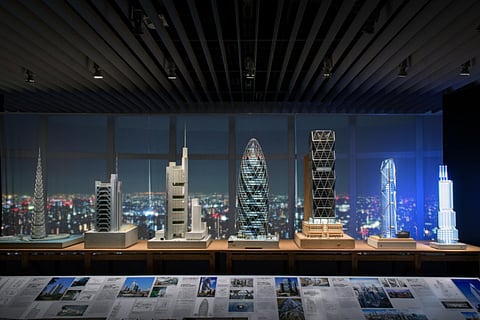Design Diary: Sustainable design in the Middle Eastern context
Foster + Partners unveil the season’s must-see exhibition at Dubai Design District

Foster + Partners have a storied history with the Middle East. Active contributors to the evolving image of the region, the UK-headquartered firm continues to plant their thoughtful urban interventions into the region’s skyline. Case in point: the Index Tower and the ICD Brookfield Place development in the UAE, the Jabal Omar development at Mecca in Saudi Arabia, the upcoming Kuwait International Airport and the 3Beirut development in Lebanon that was completed in 2018 and is credited with revitalising the Lebanese capital.
Their exhibition, ‘The Art of Sustainable Architecture’, is a new chapter in the studio’s ongoing conversation on sustainable design that was initiated by founder Sir Norman Foster in 1967. Focusing on the importance of human experience in the design of the built environment, they exhibition investigates the work of the practice through the lens of sustainability and expands on their approach in light of the 2015 Paris Agreement.
Speaking exclusively to tabloid! Gerard Evenden, Head of Studio, Foster + Partners said: “We feel this was an optimal time to raise questions about the future of our world, which will rely increasingly on a mixture of technology and renewable energy to create a sustainable future for all.”
The wide variety of projects on display in Building 6, d3, have been thematically arranged using the triple bottom line of environmental, social and economic sustainability — the three interdependent and mutually reinforcing themes that support holistic sustainable development. “While every project must strike a balance between these three aspects, the approach to each project varies based on the climate, geographical location, topography, building type, and its physical context” explains Evenden.
So how can the principles of sustainable design be applied to the regional and climatic context of the Middle East? “This is an aspect that the exhibition highlights extensively with an entire section based on designing for hot and arid regions,” he says. “We have outlined five different aspects — Form and Density, Light and Shade, Ventilation, Materiality, Technology — that are key to our design approach.”
From the study of vernacular urban planning — featuring compact city plans with narrow streets that can maximise shading for urban walkways and natural ventilation techniques such as wind towers and courtyards, to investing in technologies that can best harness sunlight and optimise water use and exploring new materials, the path to sustainable design in the Middle East can be charted in a manner that is respectful and responsive to the unique demands of the region.
“There is a rich potential in the region as it looks towards a post-oil future,” says Evenden. “The Middle East continues to demonstrate a real commitment to sustainable development, which we first experienced while working on Masdar.”
While giving a wide overview of the practice’s contribution to sustainable design, the exhibition also invites the audience to creatively speculate about what their surroundings may be like over the next fifty years and beyond.
Some of the exhibited projects include those that will further the studio’s nuance approach to sustainable and contextual design to the Middle East.
Connecting the cities of Makkah, Madinah, Jeddah and the developing King Abdullah Economic City, the Haramain High-speed Railway is a major infrastructure project for Saudi Arabia. Completed in 2018, the modular approach to the stations’ design is complemented by variations in colour, which signify the four cities while remaining emblematic of the HHR system. The glazed entrances to the concourse and the platforms are concealed behind a combination of external mashrabiya and the deep overhanging roof canopies that help control internal climate while lending shade outside.
With a 1.5 million square foot office and retail space, the ICD Brookfield Place is fast nearing completion. Featuring a 53-storey tower whose composite structural frame optimises the use of steel and concrete, adjacent to a substantial retail centre and a civic plaza, the project is designed to create a new community space for Dubai.
Scheduled to open in 2020 in the UAE and projected to achieve a LEED Gold status, the Seven Gardens resorts will be located on the edge of the Marasi Marina, a waterfront between Downtown Dubai and d3 that is set to become a major destination in the Emirate. Seven vertical gardens will form the environmental and social focus of this project.
Located in Building 6 Atrium at Dubai Design District, the exhibition runs until February 28.
Sign up for the Daily Briefing
Get the latest news and updates straight to your inbox

